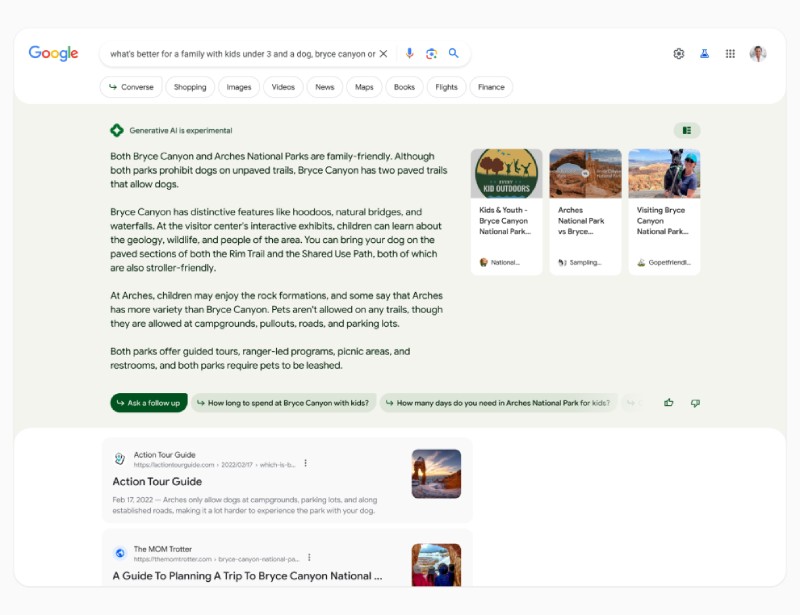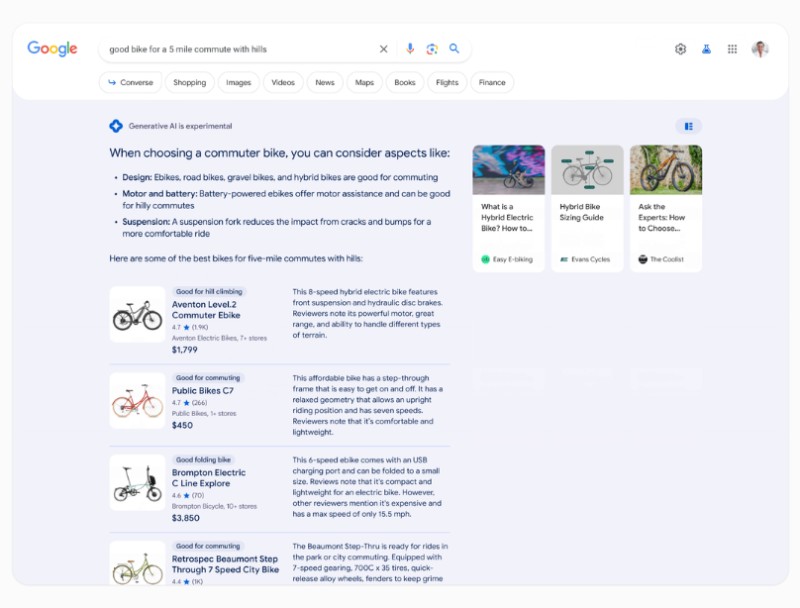Google’s generative AI SERPs response, Search Generative Experience (SGE), promises to have quite an impact on user search experience and behaviour. In turn, SGE will present a host of new challenges to the SEO world — some would argue that it’s the most significant development to Google Search in decades.
It’s an intimidating prospect, but with a clear understanding of what Google SGE is and how it fits into the SERPs ecosystem, you can leverage this imminent technology to boost site performance, even if the opposite seems to occur initially.
Read on to learn more about Google SGE and how to prepare for the new face of Google’s SERPs.
What is Google SGE?
Google SGE (Search Generative Experience) is an artificial intelligence technology with generative capabilities, meaning it can create or “generate” content, search results to be exact.
An SGE-augmented search would start as a search always has — with the user typing something into the Google search bar and clicking Enter. In this moment, SGE will filter the web for relevant information, and instead of the usual rich snippets at the top of the SERPs, users will be presented with a sizable AI generated result.
What separates this result from traditional snippets is that it distils information from numerous pieces of content across a variety of sources rather than being the source itself, presenting a freshly composed piece of content tailored to the user’s needs.
Google is referring to this as an AI snapshot.
This snapshot can be both specific and broad in that it will convey a direct answer to the user’s query while also providing contextual information.
Is Google SGE just blended SERPs results?
While its core functionality relies upon filtering and merging information, Google SGE does more than collate data from diverse online locations.
Making use of PaLM 2 - a large language model (LLM) - the SERPs response can infer results and help users find what they’re looking for in record time.
Users can also ask SGE follow-up questions, opening new search results based on the context of their original query and saving users from returning to the main search bar.
What’s more, with a nuanced and ever-growing understanding of natural language, SGE can process incredibly long, complicated queries and still deliver accurate results. Again, this eliminates the need to use the primary search bar as frequently.
However, do bear in mind that this isn’t an exhaustive list of SGE’s functionality.
Google is developing new SGE facilities in response to user feedback in the US and will likely continue to do so until the company feels users are getting maximum value from the tool.
Elaboration links are just one example of an SGE feature based on user feedback. Hover over these links and users see a definition or greater explanation of the anchor text (like on Wikipedia) helping to speed up the research of complex topics.
Why has Google developed SGE?
Google’s primary objective in developing a generative AI response is to establish a more streamlined search experience that provides greater value to users faster than ever before, but that’s not all…
The announcement of a generative AI response in Google’s SERPs may have come as a surprise to many, but our Head of SEO, David, suggests that there have been signs that something like SGE was potentially on the way, as well as clues to Google’s motivations:
In recent years, the main changes to the algorithm have focused on E.E.A.T.; the Helpful Content update; the Bert update; and improving Quality, Relevance and Useability factors - these all utilise elements of AI.
They [Google] have also been perfecting the AI aspects in the search structure, such as predictive search and SERP feature priority and building it to understand search intent and search competitiveness factors.
Google have also hinted at various times over the past 10 years about more monetisation of search and making it more of a platform in its own right rather than a gateway.
This update [August update] could be bringing all the AI fragments together in readiness for the likes of SGE — GA4 has also been structured to prepare for these changes coming up, again being built on AI.
David’s point about transforming Google SERPs into a platform sheds light on another reason Google feels the need to throw their hat in the generative AI arena — competition!
With the likes of ChatGPT performing a very similar function as Google Search, many aren’t relying on Google as much as in the past, using it more as a site directory than a deeper well of information.
In SGE, Google has found a way to level the playing field and futureproof their service.
What does Google SGE look like on Google SERPs?
Given the versatility of SGE, predictably, it takes up quite a lot of SERPs real estate, but as they’ll be tailored to suit query intent, the responses won’t always look exactly alike.
Generally speaking, the response will take up most of the display, presenting the key information front and centre, with three carousel links to relevant sites situated to the right.

How will search ads be impacted by Google SGE?
Google’s exact words on the subject of search ads and SGE are as follows, ‘Ads will continue to appear in dedicated ad slots throughout the page.’
It’s quite a vague response, but one commercial query visual released by Google does show product ads running along the top of the SERPs, then once the AI snapshot is ready, it draws the ads down vertically into the result.

Whether this is how things will remain is yet to be seen, but wherever search ads end up on the SERPs, Google has promised that they will remain distinct from organic results.
How will Google SGE affect user search behaviour?
There’s been a lot of speculation about the prospective impact of Google SGE on search behaviour and site performance, and we covered some possibilities when Google first revealed they were working on a generative SERPs response.
Based on what we now know, we can narrow it down to the following factors
- Reduced traffic (initially) - Site traffic will see an initial dip as more people opt in for SGE responses. The question is… how deep?
An Ahrefs study illustrated that traditional rich snippets were capable of syphoning an average of 6.4% of clicks from the top organic result on Google’s SERPs, so we can treat this as the baseline degree of traffic disruption when SGE is rolled out to the masses.
But being that SGE is a more comprehensive and engaging SERPs response, it’s very likely that high-ranking organic listings will lose an even greater fraction of their usual traffic, at least to begin with.
- Increase in long-tail key search terms - As SGE can interpret long strings of language to provide highly refined results in a single search, it’s inevitable that the popularity of fat head keywords will dip, while the popularity of extremely specific long-tail keywords will skyrocket.
- Lower search volumes overall - The rise in prominence of long-tail keywords will lead to lower search volumes in general, as users won’t feel the need to type in multiple queries to find what they’re looking for. Instead, they’ll type long, individual queries to generate adequate results.
- Reduced PAA (People also ask) engagement - With the follow-up question feature of SGE fulfilling an almost identical purpose as Google’s ‘People also ask’ feature, it’s highly probable that PAA user interaction will drop dramatically.
Does Google SGE mark the end of site traffic?
Google needs websites and content as much as site owners need Google. If organic traffic were to go into terminal decline, Google would suffer in three key ways:
- No human content for SGE to utilise - all generative AI uses what’s already out there to learn and create. If traffic declined to the point that site owners stopped producing content, SGE would stagnate, limiting its effectiveness.
- People wouldn’t use Google as much - for the same reason we value handcrafted products more than we value machine-produced goods, we prefer human-crafted content, especially when it comes to reviews and other forms of content centred around human experience and expertise.
If traffic fell and content production halted, Google would lose value on the whole, and user numbers would drop.
- The company would lose money - Over 60% of Google’s revenue is generated by its ad services. If search and display ads stopped generating traffic, companies would stop paying for them, leaving Google seriously light of pocket.
Google understands that in order to thrive, it must lay the groundwork for websites to thrive as well, meaning it’s essential that SERPs updates come hand in hand with traffic-generating features.
Will Google SGE appear in every search?
Google SGE isn’t going to completely dominate the SERPs for every Google Search.
Generative AI is far from a perfect technology, even when trained by Google’s hallmark systems. For this reason, the company has ‘applied additional guardrails, like limiting the types of queries where these capabilities will appear.’
Oftentimes, users will still be reliant on organic SERPs results to find their answers, meaning if you can climb the ranks, you’ll receive a significant amount of traffic from Google.
Getting ready for AI SEO?
While disruption is inevitable in the immediate future, we have a number of tips for capitalising on Google SGE in the long run.
Don’t rely solely on technical SEO (but don’t neglect it either)
Over the last half-decade, Google has downgraded or removed many of its built-in technical requirements for ranking, instead positioning content quality as the most important signifier of value.
To drive this change, Google has been placing more of an emphasis on user behaviour as a ranking tool — what users click on or scroll by says volumes about what they’re looking for and how valuable SERPs results are.
The company’s August update seems geared to reinforce this shift, placing content quality on an even higher pedestal, so it’s crucial that site owners work hard to create SME (Subject Matter Expert) content that adheres to Google’s E.E.A.T. concept - Experience, Expertise, Authoritativeness, Trustworthiness.
Our Head of SEO expands upon this approach with his own acronym, E.Q.U.A.T.E.R.:
Develop a business with Experience, Quality, Usability, Authority, Trust, Expertise, and Relevance in mind — that just about covers everything Google is looking for now when organising ranking.
Following this advice will give you the best chance of receiving traffic from SGE features such as the carousel links that appear on the right-hand side of the AI snapshot.
If your traffic declines after the August update and as SGE grows in popularity, don’t go looking for technical resolutions exclusively. But that’s not to say that you should neglect the technical side of SEO either, as it can still bring numerous benefits, especially where it overlaps with facets of content and site quality.
For example, metadata, site and content usability, and user flow are all seen by Google as quality indicators that enhance user experience either in the SERPs or on your site.
Shift more focus to long-tail & conversational keywords
As mentioned earlier, SGE will encourage the use of longer, more natural and interactive search terms, so shorter keywords are set to fall in popularity.
In order to tailor content to the evolving search intent of users, it’s essential that you work longer, richer, more conversational keywords into your content strategy.
Optimise for engagement
We and other search experts forecast the importance of engagement metrics in landing SGE snapshot features.
It’s difficult to point out the most essential of these metrics at this time, but taking a comprehensive UX approach to improving engagement should position you as a top contender for AI snippets.
We recommend:
- Optimising the technical aspects of your site that improve user experience, such as load speed and mobile-friendliness.
- Utilising a variety of content formats to boost accessibility — instead of just text-based content, use videos or helpful infographics.
- Using the topic cluster model for your site architecture. You can then thread relevant internal links throughout your content to encourage more action events and keep users in your ecosystem.
Strive for originality
While not technically a new recommendation, Google SGE doesn’t change the fact that your content should provide users with something unique.
One of the most important elements of quality content in Google’s eyes is originality, and with Google leaning more towards quality aspects of SEO, this should be a priority for all site owners.
Do lots of competitor research, not necessarily to borrow ideas, but to establish what others aren’t doing. You can then fill these gaps in the content market with your own high-value offerings.
We find that it helps to think of content as a product — why would someone be interested in a new product that does exactly the same thing in the same way as pre-existing products?
Your product needs to solve a new problem or solve old problems in a more efficient and effective way!
Optimise your featured photos
When Google SGE links to your site, it will show a scaled-down thumbnail of your page’s featured image. It may be small, but this image can have a mighty impact on CTR, so don’t let it be an afterthought.
Here are some general rules of thumb for optimising your featured images for their moment in the AI spotlight:
- The element of the image that communicates the topic should be centred. Off-centre subjects obscure the image message.
- The image should be clear when minimised.
- Bright colours in the foreground, background or both will make your image more eye-catching.
- Avoid dark or muted colours as they fade into the SERPs backdrop.
Measure the impact of Google SGE
Monitor search behaviour over the months proceeding the full release of SGE to establish the concrete impacts of the generative AI response.
You can then use your data to revise your SEO strategy and compete for new forms of exposure, such as the snippets to the right of the AI snapshot or the elaboration links available to ‘SGE While Browsing’ users.
One of the main reasons this update is causing such an uproar is that there are a lot of unknowns to contend with, so using data to answer the questions we have now as soon as it’s available will be the quickest way to effectively adjust your SEO efforts.
Establish a healthy AI assisted approach to content creation
One of the small details that seems to have been buried by the larger buzz following SGE is that Google announced that it will not penalise AI-produced content so long as it is high quality and provides value to the user.
Considering the current state of AI content creation tools, the only way to meet Google’s high standards for usability is to use AI to augment human content creation processes. This way, you can speed up the production of content without sacrificing quality.
Bottom line
Google SGE will be a learning curve for all of us, but adapting to suit the requirements of this new feature will only strengthen our efforts to rank in the SERPs and generate user engagement.
Contact us if you’d like to discuss Google SGE in more detail or would like a helping hand preparing for its arrival.

